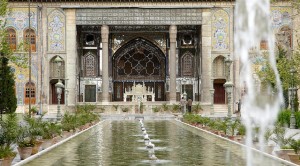 Iranian Cultural Heritage and Tourism Organization (ICHTO) is planning to celebrate inscription of Golestan Palace on UNESCO list during an official ceremony.
Iranian Cultural Heritage and Tourism Organization (ICHTO) is planning to celebrate inscription of Golestan Palace on UNESCO list during an official ceremony.
President Mahmoud Ahmadinejad along with several Iranian officials are to attend the ceremony that will be held at Golestan Palace on July 7, 2013.
Iran’s Golestan Palace was inscribed on the UNESCO World Heritage List, during the recent summit held in June.
The United Nations Educational, Scientific and Cultural Organization made the decision during its World Heritage Committee’s 37th annual session in Phnom Penh, Cambodia.
The palace was built in Tehran in the 16th century when the Safavid Dynasty was ruling Iran.
The site received its most characteristic features following extensions in the 19th century, when the ruling Qajar family selected the palace as the royal residence and seat of power. Golestan Palace currently consists of eight key palace structures mainly used as museums.
“The Golestan Palace is considered of Outstanding Universal Value because it is presented as the most complete and only remaining example of a royal palace which is an architectural masterpiece of the Qajar era,” the International Council on Monuments and Sites (ICOMOS) had earlier said in a statement.
The committee also assessed Iran’s Meymand Cave Village along with 32 other submitted sites from around the world for a possible inscription on the World Heritage list.
World Heritage site is a title that is given to the locations, which have "outstanding universal value" to all of humanity, according to the UNESCO description.
This year’s session of UNESCO World Heritage Committee also removed Iran’s ancient Bam Citadel from its List of World Heritage in Danger as the members recognized that remains of the historical citadel had been sufficiently stabilized.
Naqsh-e Jahan Square, Armenian monastic ensembles of Iran, Bam and its cultural landscape, Bisotoun, Pasargadae, Persepolis, Sheikh Safi al-din shrine, Shoushtar historical hydraulic system, Soltaniyeh, Tabriz historic bazaar complex, Takht-e Soleiman, Tchogha Zanbil and the Persian garden are among the Iranian historical heritage inscribed on UNESCO’s World Heritage List.
By Press TV
The Iran Project is not responsible for the content of quoted articles.

 QR code
QR code